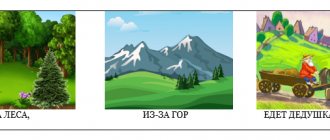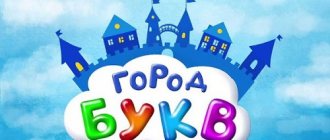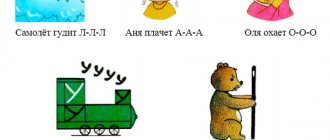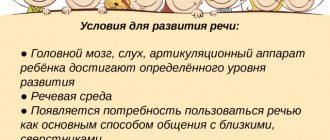Working in words
You need to choose only those words that contain a practiced syllable. The work is carried out in the following order:
- the sound is at the beginning;
- in the middle;
- at the end.
Automation begins with words with forward and backward syllables. It is advisable to illustrate each name, invite toys to “visit” - all this will make the lesson not only more interesting, but also more effective.
Examples of exercises
Similar to the previous stage, in the first lessons the speech material is spoken by an adult, then together with the student, and then the child repeats it independently. Gradually, when there are more practiced words, the baby names them without prompting from the speech therapist.
At the stage of automation of phonemes in words, work is carried out in parallel on the development of phonetic-phonemic processes. The child is explained where the word has a beginning, middle and end. During the classes, word diagrams are drawn up and tasks for the development of auditory self-control are offered.
At the same stage of automation, the gradual introduction of the automated phoneme into coherent speech begins. They do this using the example of phrases, Ш or Ж can be either in one or in each word:
- Repetition of words:
SHA: ball, cap, puck.
SHU: noise, fur coat, joke.
JA: toad, heat, sting.
And in this way they select words for each practiced syllable.
- The child is asked to listen carefully to the words and correct the adult. An adult deliberately makes mistakes in the pronunciation of the automated sound in some words. This task is aimed at developing auditory control of speech.
- Add the desired syllable to make a word. Pictures are used with children of primary and middle preschool age to make it easier for them to complete this task. For example, given an image of a cap and the second syllable – PKA. The child needs to add a syllable from the proposed options (SHA).
- Repetition of words with two sounds Ш or Ж. For example: bump, panties, kidding, etc.
- Repetition of phrases: On W: grandfather’s checkers, new hat, funny joke, sewing machine.
- On F: a beetle is buzzing, an orange jacket, liquid jelly.
When the child manages to pronounce the sound in words correctly, they move on to a more complex stage of correctional work - automating sounds in sentences. This block is longer in terms of the proposed material, because it is a preparation for the introduction of an automated phoneme into coherent speech.
Speech material:
On the edge
Alyonushka went to the forest. I picked a basket of berries. She went out to the edge. At the edge of the chamomile. There are bugs on daisies. There is a river nearby. There are reeds near the river.
Chess and mice
Two mice were making noise and joking at the edge of the forest. The little mice found a chess set near the chestnut tree. They went into the reeds so as not to be disturbed. Silence in the reeds: no noise, no whisper. The mice became fascinated by chess.
Fur coat for Pushka
Masha and Natasha sew a fur coat for the kitten Pushka. Fluffy is unhappy. He hisses: “Well, no! I won't wear your fur coat! My fur coat suits me better.”
Good in the countryside
It's nice in the village in summer. Mashenka and her grandmother woke up early, took baskets and went into the forest. It's good to breathe fresh air. Grandmother and Mashenka went out to the edge of the forest. Grandmother sat down to rest, and Mashenka watched the birds and listened to the cuckoo. Mashenka is happy: if you want, you can pick daisies and weave wreaths, if you want, you can catch butterflies or just lie on the grass!
Pushinka
Our cat's name is Pushinka. Grandfather named her that because of her fluffy fur. We have a beautiful cat, but naughty. One day my grandmother came from the market and brought sour cream in a jug. Fluffy smelled sour cream. When grandma left the kitchen, Pushinka jumped onto the large table and ate all the sour cream.
Teddy bear
Alyosha has a teddy bear. The bear has a smooth, velvety skin and ears on the top of its head. Grandfather bought Alyosha a big car. Alyosha rolled the bear in the back. And then I decided: let the bear be the driver. And now the bear rides in the cab.
Masha and Natasha
Our Natasha is a schoolgirl. This year she went to first grade. And Masha is younger than Natasha. But Masha knows how to sew. Grandfather Pasha gave Masha a sewing machine. And Grandma Dasha gave Masha a box. Masha's box contains needles, threads, bobbins and spools.
Types and mechanisms of violations
Incorrect pronunciation of a hissing group is called sigmatism, and their replacement with other sounds is called parasigmatism. Sh may be absent from a child’s speech, but he will not replace it with other phonemes. There are several types of hissing sigmatism, differing in the mechanism of occurrence:
- Interdental – speech with such distortion is called a lisp. With this sigmatism, the tongue does not take the desired “cup” position, but passes between the teeth. The cause may be a short hyoid frenulum; high and narrow sky.
- Lateral - in speech, instead of Ш, a sound is produced that has a “squelching” sound. During pronunciation, one corner of the lips rises higher than the other; the lower jaw is also shifted to one side; the “cup” shape does not work out because the back of the tongue forms a connection with the dental alveoli on only one side. The reason for the appearance of such distortion may be weak tone of the articulatory muscles and incorrect bite.
- Nasal - instead of Ш, the child pronounces X with a nasal connotation. The tongue is in a lower position, and the back is raised up. It is because of the high tension on the back of the tongue that this sigmatism appears.
Depending on the type of hissing sigmatism, the speech therapist will select the method of sound production.
Sh pronunciation is normal
This sound is the basic one in the hissing group. Having mastered its articulation, the child will easily learn to correctly pronounce other sounds from this group. The lips take a “horn” position: they are pushed forward a little so that a “window” shape is obtained. When pronouncing a sound, the teeth must be closed.
The tongue should be in a “cup” position: the tip is behind the upper teeth, and its sides are pressed tightly against the teeth. This allows you to direct the exhaled stream in the middle. If everything is done correctly, it will turn out wide and warm. The vocal cords are open, so Ш is a voiceless consonant.
Setting option when there is no sound
If a child does not have Sh in his speech, and he does not use other phonemes instead, then the main emphasis is on articulatory gymnastics, namely the formation of a wide tongue rise. When the “Cup” exercise is performed correctly, the speech therapist begins to produce sound.
He asks the child to make a “Cup” and hide his tongue behind his teeth. Next, the speech therapist explains that you need to blow on your tongue and then you will get Sh. If the child pronounces X, then a clear hissing sound will not be produced. For convenience, they suggest pronouncing C, only the tongue is behind the upper teeth. To develop the correct pronunciation, you need to repeat it many times. To increase the effectiveness of classes, the speech therapist uses didactic games.
Setting Sh with distorted pronunciation
The method of presentation depends on the type of sigmatism. Each of them has its own reasons, so the speech therapist selects techniques to correct them:
- With the interdental variant, exactly the same preparatory work is carried out as in the absence of a phoneme in speech. The emphasis is on raising the tongue, so they additionally practice clear pronunciation of T, from which the sound will be made. When pronouncing T, the child keeps his mouth open. You need to pronounce the sound slowly, adding aspiration. Gradually, the speech therapist teaches the child to lengthen the air stream and not touch the tubercles with the tongue.
- For lateral distortion, a mechanical method is used. Before insertion, the lateral edges of the tongue are strengthened; They teach you to raise and hold your tongue behind your teeth, and form a strong, long, directed exhalation. For placement, you can use a special speech therapy probe or a teaspoon (if you are doing correction at home). Using a probe or spoon, the front part of the tongue is lifted and removed behind the upper teeth, moving it closer to the tubercles. The child bites the spoon and pronounces S. Gradually, the duration of exhalation increases, and the ability to lift and hold the tongue in the desired position independently is formed.
- The method of setting from P - this method is rarely used, because to pronounce a sonorant group the tongue occupies a similar position as for sibilants. Therefore, few children can speak R correctly if they have problems with the pronunciation of sibilants. The child, keeping his mouth open, pronounces R silently. An adult, using the handle of a teaspoon, stops the vibration. The result is hissing. Gradually, the spoon is used less, the child learns to keep his teeth together and make a hissing sound without mechanical assistance.
- Method of setting from whistlers. The child pronounces an elongated S, the adult places a teaspoon or probe under the front edge of the tongue, lifts it and moves it deeper into the mouth until he hears Sh in speech. Gradually, the child learns to independently lift and cup his tongue.
If there are disturbances in the tone of the tongue muscles, a course of speech therapy massage is prescribed. It is performed using probes (for this you need to undergo special training) or fingers wearing sterile disposable gloves. But along with the massage you need to do articulation gymnastics. Then the preparation of the organs of articulation for the production of Ш will be more effective.
The sound Ш is the main one in its group. Therefore, having corrected its pronunciation, it is easy to add other sibilants. You just need to explain the difference in articulation so that the child does not mix them up in speech. You need to start producing other hissing sounds when you have passed the stage of automating the sound Ш in speech.






